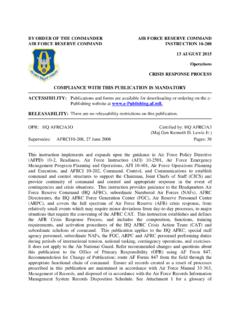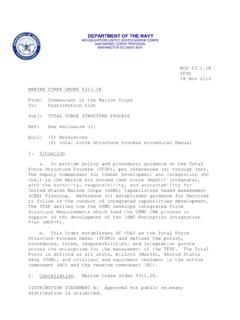Transcription of BY ORDER OF THE AIR FORCE POLICY DIRECTIVE 10 …
1 BY ORDER OF THE SECRETARY OF THE AIR FORCE AIR FORCE POLICY DIRECTIVE 10-4 30 APRIL 2009 operations operations PLANNING: AIR & SPACE expeditionary FORCE (AEF) COMPLIANCE WITH THIS PUBLICATION IS MANADATORY ACCESSIBILITY: Publications and forms are available for downloading on the e-Publishing website at RELEASABILITY: There are no releasability restrictions on this publication. OPR: AF/A5XW Certified by: AF/CC (Gen Norton A. Schwartz) Supersedes: AFPD10-4, 16 June 2004 Pages: 13 To meet Combatant Commander (CCDR) requirements across the entire range of military operations the Department of Defense (DoD) implemented the Global FORCE Management (GFM) system. This AFPD directs implementation of Title 10 USC guidance on Service responsibilities; and the following DoD Directives (DoDD): , Equipping the Reserve Forces; , Activation, Mobilization, And Demobilization of the Ready Reserve and , Planning, Programming, And Budgeting System (PPBS); DoD Instruction (DoDI) , Organizational and FORCE Structure Construct (OFSC) for GFM; Management Initiative Decision (MID) 913, Implementation of a 2-Year Planning, Programming, Budgeting, and Execution (PBBE) Process, and the following Chairman of the Joint Chiefs of Staff (CJCS) Manuals (CJCSM): , Joint Operation Planning and Execution System (JOPES) Volume I (Planning Policies and Procedures).
2 , Joint Operation Planning and Execution System (JOPES) Volume III (Crisis Action Time-Phased FORCE and Deployment Data Development and Deployment Execution); , Joint Operation Planning and Execution System Volume II, Planning Formats and Guidance; , Joint Operation Planning and Execution System Reporting Structure (JOPESREP); and CJCS Instructions (CJCSI): , Joint Strategic Planning System and , The Functional Capabilities Board Process. This document provides AEF POLICY to all Air FORCE , including air reserve component forces (ARC). Refer recommended changes and conflicts between this and other publications to AF/A5XW, 1480 Air FORCE Pentagon, Washington 20330-1480, on the AF Form 847, Recommendation for Change of Publication; route AF IMT 847s from the field through the appropriate functional s chain of command.
3 Ensure all records created as a result of processes prescribed in this publication are maintained in accordance with AF POLICY DIRECTIVE (AFPD) 33-3, Information Management and AF Manual (AFMAN) 33-363, Management of Records, and disposed of in accordance with the Air FORCE (USAF) Records Disposition Schedule (RDS) located at SUMMARY OF CHANGES This POLICY DIRECTIVE incorporates aspects of global operations planning and directs AEF FORCE management, FORCE allocation, and battle rhythm management synchronized with the GFM process to 2 AFPD10-4 30 April 2009 support CCDR requirements. This AFPD aligns actual tempo requirements with a matching FORCE generation model under a Tempo Band construct, applies rule sets for forces operating at a tempo of less than 1:4 deploy-to-dwell, aligns AF planning periods with GFM, provides an enterprise view of Service risk synchronized with GFM risk definitions, and directs the annual reassessment of planning assumptions based on emerging/rotational requirements.
4 Tempo Bands will align AEF battle rhythms, provide increased predictability of vulnerability period, and synchronize with the Secretary of Defense s (SecDef) 12-month GFM planning cycle. The Air and Space expeditionary FORCE Center (AEFC) was realigned under the Air FORCE Personnel Center (AFPC) and identified as the AFPC Directorate of AEF operations (AFPC/DPW). The roles and responsibilities of Commander Air Combat Command (COMACC) in relation to AFPC operations Support Center and execution of the AEF schedule have been redefined. 1. AEF Roles and Responsibilities. Secretary of Defense (SecDef). Prioritizes competing requirements for limited resources through the GFM and Individual Augmentee (IA) process. The SecDef approved allocation is DIRECTIVE to all Services and CCDRs. The capabilities may be required to enter surge to meet SecDef intent as directed in the approved GFM and IA guidance.
5 Combatant Commanders (CCDR). Submit requirements for rotational, emergent (often called Request for Forces/Request for Capabilities (RFF/RFC)), exercise, contingency, and IA forces through the GFM process. The SecDef is the adjudication authority for prioritizing competing CCDR requirements, approving FORCE allocation actions, transferring operational control to supported commanders by attaching forces, and making the determination to surge or limit forces. Commander US Joint Forces Command (CDRUSJFCOM). The SecDef and Unified Command Plan (UCP) designate CDRUSJFCOM as the Primary Joint FORCE Provider (JFP) for recommending global sourcing solutions from assigned and unassigned conventional forces and capabilities (except for those forces sourced by United States Special operations Command (USSOCOM), United States Strategic Command (USSTRATCOM), and United States Transportation Command (USTRANSCOM)) to support SecDef s GFM allocation decisions.
6 Secretary of the Air FORCE (SECAF). SECAF has statutory responsibility to provide trained, equipped and ready forces to meet CCDR requirements (10 162). In accordance with Title 10 United States Code and following SecDef approval, SECAF assigns AF forces, except those necessary to meet statutory functions of 10 8013, to the CCDRs. SECAF has authority over all forces not specifically assigned to CCDRs. Assistant Secretary of the Air FORCE for Manpower, Reserve Affairs (SAF/MR). Provides mobilization recommendations to the SECAF and Office of the Secretary of Defense (OSD) Reserve Affairs in coordination with AF/A3/5. Chief of Staff of the Air FORCE (CSAF). SECAF delegates to CSAF the authority to support CCDRs through the AEF. To fulfill this responsibility, the CSAF coordinates with supported CCDRs and tasks AF forces to provide ready capabilities as directed by GFM.
7 Tasks all regular AF, Air FORCE Reserve Command (AFRC) and Air National Guard (ANG) units via the AEF schedule to be ready to deploy at any time during their AEF vulnerability period or as required to support contingencies. Notifies SECAF, CJCS and supported CCDRs of the need to alter deploy-to-dwell ratios to meet requirements and the percentage of affected AEF assets. AFPD10-4 30 April 2009 3 Vice Chief of Staff of the Air FORCE (VCSAF). The VCSAF or designated Office of Primary Responsibility (OPR), acting on behalf of the SECAF and in accordance with AFI 38-101, Air FORCE Organization, and AFI 51-604, Appointment to and Assumption of Command, establishes new Air and Space expeditionary Task Forces (AETF) that consist of expeditionary numbered AFs, wings, groups, and/or squadrons, appoints AETF commanders, and specifies administrative control (ADCON).
8 Deputy Chief of Staff for operations , Plans and Requirements (AF/A3/5). Pursuant to SecDef approved GFM FORCE allocation guidance, has full authority, working with the JCS, to organize and allocate AF forces to meet CCDR requirements via the AEF. Serves as the primary advisor to CSAF on AEF matters and is the single USAF point of contact to the Joint Community on all matters involving FORCE management POLICY , guidance, and procedures. Deputy Chief of Staff for Manpower and Personnel (AF/A1). Provides visibility and accountability of deployed Airmen through the AFPC. Advises the CSAF on matters of personnel rotation management, end strength accounting, rotation pivot dates, personnel rotation planning and deploy-to-dwell ratios, line remarks, tasking notification, AEF debriefs, and the executive review process.
9 Respective MAJCOM/A1 prepares, in accordance with AFI 51-604, Appointment to and Assumption of Command, orders for newly organized AETFs, and specifies ADCON passed to the theater COMAFFOR in accordance with AFI 38-101, Air FORCE Organization. Assists the COMAFFOR in preparing G-series orders for AETF subordinate units. Air FORCE Personnel Center (AFPC). Executes AEF sourcing, scheduling POLICY and provides visibility and accountability over deployed AF forces to assess readiness and projected reconstitution requirements. Integrates and executes personnel operations , Airmen development and meets commanders' personnel requirements. Responsible for sourcing IA, Joint Manning Document authorizations, and managing replacements for 365-day or greater requirements. Air Combat Command (ACC). COMACC, through ACC as the Air FORCE component to JFCOM, coordinates with other AF Major Commands/Direct Reporting Units/Field Operating Agencies (MAJCOMs/DRUs/FOAs) and HQ USAF to identify AF recommended sourcing solutions for all AF conventional forces (whether assigned or unassigned) in support of USJFCOM s role as Primary JFP in accordance with GFM guidance.
10 ACC coordinates and prepares rotational FORCE schedules, rotational FORCE allocation plans, recommended sourcing solutions, and military risk assessments for the Joint Staff (JS) to be submitted to SecDef for final approval. (Reference Management Transformation and Consolidation PAD 07-13, Annex C, Appendix 2, Tab M) Scheduling Integrated Process Teams (SIPTs). Combat Air FORCE (CAF) SIPT. ACC/A3 is responsible for conducting CAF SIPTs to develop the Consolidated Planning Schedule (CPS), facilitate development of the AEF schedule and implement the GFM Appendixes. CAF SIPT procedures are conducted IAW AFI 10-420, Combat Air Forces Aviation Scheduling. expeditionary Combat Support (ECS) SIPT. AFPC/CC is responsible for conducting ECS SIPTs to facilitate the ECS portion of the AEF schedule, develop target base alignment template, and implement the GFM Appendixes.













